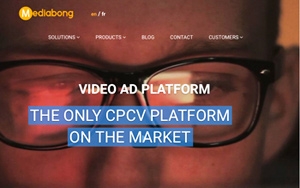Weed, VTR & Engagement: A Chat With Mediabong's CEO
- by Felicia Greiff , February 10, 2016

Video ad platform Mediabong is launching its Syncroll product Wednesday.
The Paris-based company analyzes real-time viewer behaviors and measures interest in an ad to modify the way an ad is displayed.
What's probably most interesting to an industry plagued by distrust and a yearning for more metrics is that Mediabong guarantees a 100% attention and viewability standard. (More on that, and the company's name, below.)
Syncroll has a DSP and an ad exchange to manage campaigns on a cost-per-completed-view (CPCV) basis. Along with features like user profile targeting and user attention levels, the platform also has a "behavior feature" to drive attention and viewer completion to 100%.
Below is a lightly edited and condensed conversation via email with Laurent Bury, CEO of Mediabong.
Real-Time Daily: Three months ago, Syncroll started beta tests with brands including Volvo, Walmart and Chrysler. Can you talk about results from that phase?
Laurent Bury: They’ve been impressive, as we saw a minimum increase of 30% for all the traditional KPIs, with some notable success such as a 6.1% click rate for one of our partners.
RTD: You now have an office in New York. Do you get a lot of weed jokes related to your company name?
Bury: Yes, very often! But it is like an ice breaker, and most of the time people love the name! We haven't had a weed company from Colorado knocking at our door to run a video
ad campaign yet!
RTD: What kind of viewer behaviors do you measure in real time?
Bury: This is a patented solution and our
secret sauce, so I won’t be able to give you the full details. What I can say is that there are more than 15 data sources which are tracked on a real-time basis for every user.
RTD: How are your metrics better or more complete than VTR (view-through rates) and viewability? (In a press release, Bury said the industry has relied on metrics like
VTR and viewability, which paint an interesting story but don't measure actual interested users.)
Bury: Having worked with attention specialists and run
different surveys, we have analyzed that within an article, you have two main locations in a page where user attention is the highest.
Our algorithms track user behavior while a video ad is playing within this zone. This analysis allows us to come up with an interest graph (made up of multiple data) which enables us to adapt the user video experience.
We don’t pretend to be more complete than VTR and viewability; we just say that brands should only pay for attentive users giving their time and attention to watch a video ad.
Because [viewers] take the time to watch it, this means that they are a potential engaged user. Providing 100% viewability with 100% completion into this attention zone is just the best way to measure
it.
RTD: Can you talk about the "100% completion rate with 100% attention guaranteed"? I'm interested in what clients think of that promise.
Bury: This takes into account a variety of data within certain locations on the page (99% in the main part where you find the text). The idea is pretty simple: If users don't
show attention, this means that they are not interested in your product. [In that case], you’ll get awareness (because the video is played for a certain amount of time), but we won't charge
you.
Thanks to YouTube and its TrueView ad format, clients are now pretty well-educated and understand what we deal with. It's in their best interest to be charged only when attention is there, so they can maximize their budget efficiency without paying more.


